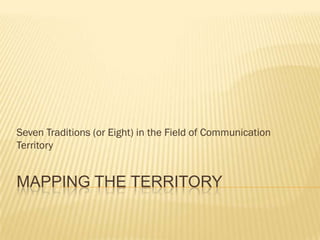
Seven Traditions in Communication Theory
- 1. Seven Traditions (or Eight) in the Field of Communication Territory MAPPING THE TERRITORY
- 2. THE ESSENTIALS OF COMMUNICATION THEORY According to Karl Popper “theories are nets cast to catch what we call the „world‟
- 3. THE ESSENTIALS OF COMMUNICATION THEORY Indeed, we use theories to guide us towards the understanding and exploration of all natural, physical and social realities that surround us. Communication is an inseparable and considerably substantial part of that world.
- 4. THE ESSENTIALS OF COMMUNICATION THEORY Communication is multidisciplinary. The elements of Communication theory are present in literature, psychology, sociology and even mathematics and engineering.
- 5. THE ESSENTIALS OF COMMUNICATION THEORY The conceptual foundations that unite communication theories 1. Communication is a process, continuous and complex. 2. Communication is symbolic. 3. Communication is transactional
- 6. THE ESSENTIALS OF COMMUNICATION THEORY “Communication is the problem to the answer” because scholars hold widely divergent views as to what communication is. There are several perspectives as to what communication is. These are referred to as traditions in the field.
- 7. WHAT IS A PERSPECTIVE OR TRADITION OF COMMUNICATION? 1. A perspective is a way of looking through, an angle of vision, a way of seeing. 2. All perspectives are therefore partial and, in that sense, distorted or biased. 3. All perspectives look at this rather than that; each has its particular emphasis. 4. This is more so in a multi-field such as communication.
- 8. FOUR MAJOR APPROACHES OF COMMUNICATION Robert Craig Alvarado & Boyd-Barrett British Film Institute (1989) (1992) BFI (1992) Boyd-Barrett & Newbold (1995)
- 9. FOUR MAJOR APPROACHES OF COMMUNICATION 7 Traditions 3 Traditions British Film Boyd-Barrett & Robert Craig Alvarado & Institute Newbold (1995) (1989) Boyd-Barrett (BFI) (1992) (1992) 1. Socio- 1. Interpretive 1. Media Agencies 1. Mass Society, Psychological 2. Media Categories Functionalism, 2. Cybernetic 3. Media Pluralism 3. Rhetorical 2. Social Technologies 2. Media Effects 4. Semiotic 4. Media 3. Political Economy Science 5. Socio-Cultural Languages 4. The Public 6. Critical 3. Practice 5. Media Audiences Sphere 7. Phenomenological 5. Media 6. Media Occupations & 8. Ethics Representations Professionals 6. Cultural Hegemony 7. Feminism
- 10. UNIVERSITY OF COLORADO PROFESSOR, ROBERT CRAIG ESTABLISHES SEVEN TRADITIONS (EIGHT) OF COMMUNICATION
- 11. TRADITIONS IN THE FIELD OF COMMUNICATION THEORY Socio- Rhetoric Socio- phenome psycholo cybernetic semiotic Critical al cultural nological gical
- 12. TRADITIONS IN THE FIELD OF COMMUNICATION THEORY Objective Territory Interpretive Territory
- 13. THE SOCIO-PSYCHOLOGICAL TRADITION COMMUNICATION AS INTERPERSONAL INFLUENCE
- 14. THE CYBERNETIC TRADITION COMMUNICATION AS INFORMATION PROCESSING
- 15. THE RHETORICAL TRADITION COMMUNICATION AS ARTFUL PUBLIC ADDRESS
- 16. THE SEMIOTIC TRADITION COMMUNICATION AS THE PROCESS OF SHARING MEANING THROUGH SIGNS
- 17. THE SOCIO-CULTURAL TRADITION COMMUNICATION AS THE CREATION AND ENACTMENT OF SOCIAL REALITY
- 18. THE CRITICAL TRADITION COMMUNICATION AS A REFLECTIVE CHALLENGE OF UNJUST DISCOURSE
- 19. THE PHENOMENOLOGICAL TRADITION COMMUNICATION AS THE EXPERIENCE OF SELF AND OTHERS THROUGH DIALOGUE
- 20. THE ETHICAL TRADITION COMMUNICATION AS PEOPLE OF CHARACTER INTERACTING IN JUST AND BENEFICIAL WAYS
- 21. 3 TRADITIONS (ALVARADO & BOYDBARRETT 1992) Interpretive Social Science Practice This division underlines the distinction between a tradition that drew on analysis of literature and film and focused mainly on the structure of the text, and a second (social science) tradition using empirical methodologies for the analysis, primarily, of production and audiences. The third, practice tradition, is the ‘how to’ approach to working in the media, which is often taught and researched separately from studies of the media
- 22. BFI, BRITISH FILM INSTITUTE, BAZALGETTE, (1992) Six (6) key aspects of communication Media Agencies Media Categories Media Technologies Media Languages Media Audiences Media Representations
- 23. BFI, BRITISH FILM INSTITUTE, BAZALGETTE, (1992) Media Agencies who is communicating and why? Media Categories what type of text is it?
- 24. BFI, BRITISH FILM INSTITUTE, BAZALGETTE, (1992) Media Technologies how has it been produced? Media Languages how do we know what it means?
- 25. BFI, BRITISH FILM INSTITUTE, BAZALGETTE, (1992) Media Audiences who receives it, and what sense do they make of it? Media Representations how does it present its subject to us?
- 26. BOYD-BARRETT & NEWBOLD (1995) Mass Society, Functionalism, Pluralism Media Effects Political Economy The Public Sphere Media Occupations & Professionals Cultural Hegemony Feminism Moving Image New Audience Research
- 27. BOYD-BARRETT & NEWBOLD (1995) Mass Society, Functionalism, pluralism This cluster of theories and approaches focuses on how the media contribute to the overall social system. It incorporates two radically different views of society: 1. the mass society 2. functionalism (pluralism)
- 28. BOYD-BARRETT & NEWBOLD (1995) Media Effects The focus is whether and under what circumstances the media influence individual or group cognitions, beliefs or attitudes and behaviours. It presumes a one-way transmission of messages that have corresponding impacts on those exposed to them.
- 29. BOYD-BARRETT & NEWBOLD (1995) Political Economy Mosco (2004) defined political economy as ‘the study of the social relations, particularly the power relations, that influence the production, distribution, and consumption of resources, including communication resources’. Political economy tends to focus on how media institutions relate to other major institutions of society, particularly the political, financial and industrial, and how these influences account for media industrial and professional practices.
- 30. JIMI KAYODE ADEBOLA ADEGUNWA SCHOOL OF COMMUNICATION, LAGOS STATE UNIVERSITY, LAGOS, NIGERIA.
Hinweis der Redaktion
- Mosco, Vincent (2004). The Political Economy Tradition of Media Research. Unit 4 of the MA in Mass Communications, Centre for Mass Communication Research, University of Leicester.
